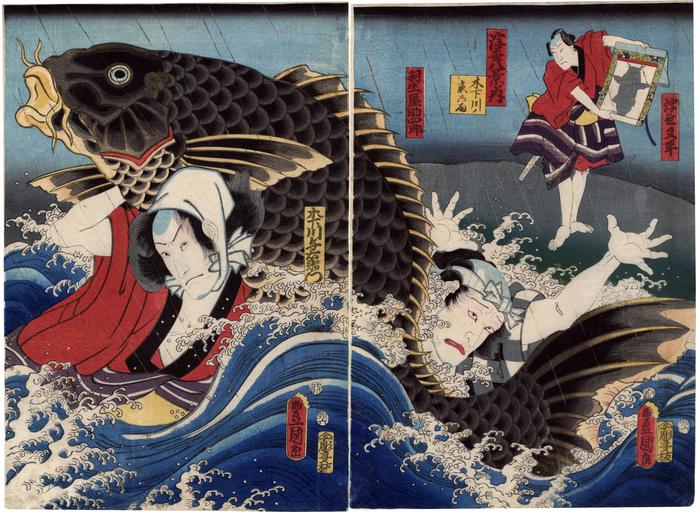Utagawa Kunisada (歌川国貞) / Toyokuni III (三代豊国) (artist 1786 – 01/12/1865)
Onoe Kikugorō III (尾上菊五郎) as Konoshitagawa Kōsuke (木下川幸助) on the left - to the right of him by the tail of the fish is Bandō Hikosaburō IV (坂東彦三郎) as Hanyuya Sukeshirō (羽生村助四郎) - standing on the shore is the painter Ukiyo Matabei (浮世絵鏡) played by an unidentified actor, possibly Bandō Takesaburō I from the series Ukiyo hakkei no uchi ('Eight Views of the Floating World' - 浮世八景ノ内)
06/1855
50 cm x 36 cm (Overall dimensions) Japanese color woodblock print
Signed: Toyokuni ga (豊国画)
Publisher: Ōtaya Takichi (Marks 423 - seal 21-245)
Censor's seal: aratame
Date seal: Hare 6 - 6/1855
Museum of Fine Arts, Boston (later version from 7/1856 with different actors)
Victoria and Albert Museum
National Diet Library
Lyon Collection - similar Shigeharu print on a related theme
Lyon Collection - similar Kuniyoshi print on a related theme Iwakiri and Newland wrote in Kuniyoshi: Japanese master of imagined worlds on p. 76, in reference to a different composition: "Illustrated here is the 'carp-grappling scene' (koi-tsukami) from the play Tenjiku Tokubei ikoku banashi (Tokubei of India: tales of strange lands) held in the eighth month of 1832 at the Kawarazaki theatre. This scene frequently took place during summer performances and used real tanks of water on stage.
In order to snare a carp that has slipped out of a scroll painting Kinegawa no Yoemon enters the water and fights his opponent Matabei. When he pierces the eyes of the captured carp with a sword, the creature re-enters the scroll."
In another entry on page 80 Iwakiri and Newland note that this scene was "...third-act grand finale (sanmakume ōgiri) in the play Tenjiku Tokubei ikoku banashi..."
****
This diptych from the Lyon Collection is extremely instructive for those who are fascinated by ukiyo-e prints because it is so similar to a diptych by the same artist and same publisher found in the Museum of Fine Arts in Boston. But they are not the same. The left panel is almost identical, but with slight differences: the actor and his identifying cartouche have been recarved. The right panel is almost entirely different. There is no man holding a scroll standing on the shore and the fellow splashing about in the waves at the tail end of the fish has been replaced by a man with a sword raised about to strike the fellow on the left. The diptych in the Lyon Collection is clearly the earlier version, dated 6/1855 while the one in Boston is dated 7/1856.
The play is Konoshita Kage Hazama Gassen (木下蔭狭間合戦) which was performed at the Morita-za.
****
There is an album of prints in the collection of the National Diet Library in which there is a copy of this diptych. However, these are crepe prints.
****
There is another copy of this diptych in the collection of Ritsumeikan University.
****
This diptych is related to the story of Rokusaburō in the play Umemoyo ukina no irozome. A description of that play was given by Osakaprints.com in reference to a Shigeharu print. (The Lyon Collection has another copy of that print at 1089.) It is described thus:
"The play was an adaptation of one of the most notorious double suicide stories (shinjû-mono), this one involving the carpenter Rokusaburō and the courtesan Osono, inspired by an actual event in 1749. (The Osaka citizenry was shocked by yet another death on the same day, when a prostitute was executed for murdering Osono's brother.)
The popular theatrical retelling also involves the theft of a precious scroll painting of a carp (koi). When Rokusaburō tracks down the thieves and wrestles the scroll away from them, the carp comes to life and escapes. Shigeharu's print shows him trying to capture the carp, a scene called koi no tsukamimono ("catching hold of the carp"). The play was performed in the summer, and real water was used on the stage (called mizuiri or "in the water").
Ōtaya Takichi (太田屋多吉) (publisher)
actor prints (yakusha-e - 役者絵) (genre)
Onoe Kikugorō III (三代目尾上菊五郎: 11/1815-3/1848) (actor)
Bandō Hikosaburō IV (四代目坂東彦三郎: 11/1816 to 2/1856) (actor)
Ōtsu-e (大津絵) (genre)
Bandō Takesaburō I (初代坂東竹三郎: from 1/1846 to 2/1856) (actor)
